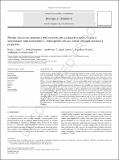Por favor, use este identificador para citar o enlazar a este item:
http://hdl.handle.net/10261/221114COMPARTIR / EXPORTAR:
 SHARE SHARE
 CORE
BASE CORE
BASE
|
|
| Visualizar otros formatos: MARC | Dublin Core | RDF | ORE | MODS | METS | DIDL | DATACITE | |

| Título: | Pehuén (Araucaria araucana) seed residues are a valuable source of natural antioxidants with nutraceutical, chemoprotective and metal corrosion-inhibiting properties |
Autor: | Gallia, María C.; Bachmeier, Evelin; Ferrari, Ana; Queralt Mitjans, Ignacio CSIC ORCID; Mazzeo, Marcelo A.; Bongiovanni, Guillermina A. | Palabras clave: | Natural product Cyclophosphamide Tannins Anticorrosive Corrosive inhibitor Quercetin EDXRF Waste Green chemistry Circular economy |
Fecha de publicación: | nov-2020 | Editor: | Elsevier | Citación: | Bioorganic Chemistry 104: 104175 (2020) | Resumen: | In the last decade, green chemistry has been attracting great interest in many contexts, including, among others, natural antioxidants. However, only a few works deal with natural residue extracts and biowaste, which could be an efficient, economical and environmentally friendly source for the production of useful compounds. In this study, we look for antioxidant activity in Araucaria araucana seeds, an iconic pine species of the Argentine and Chilean Patagonia commonly known as “pehuén”. Piñones are the edible pehuén seeds, and it is estimated that approximately 40 tons of piñones are harvested annually in Argentina and Chile. The chemical composition, antioxidants, metal corrosion-inhibiting properties and biological activity of edible and discarded piñón tissues were determined. Acute toxicity was discarded by in vitro testing and double fluorescent staining. Biological activity was evaluated in vivo by determining redox markers in salivary glands from rats treated with Cyclophosphamide (an oncological drug). All piñón tissues had antioxidants and antioxidant activity, with the coats showing the highest levels (up to 404 µg ascorbic acid equivalent per mg). The coats, in particular, had high gallic acid, catechin, quercetin and tannin contents, and more antioxidant activity, polyphenols and flavonoids than berries from the region. Results by X-ray fluorescence spectrometry showed that Na, Mg, P, S, Cl, K, and Ca were majority elements in the coat, embryo and endosperm. Furthermore, coat extract also showed significant anti-corrosion activity and in vivo protection against oxidative damage. The results indicate that piñón biowaste is a low-cost attractive source of natural antioxidants with potential nutraceutical, medical and metal corrosion protection applications. | Versión del editor: | https://doi.org/10.1016/j.bioorg.2020.104175 | URI: | http://hdl.handle.net/10261/221114 | DOI: | 10.1016/j.bioorg.2020.104175 |
| Aparece en las colecciones: | (IDAEA) Artículos |
Ficheros en este ítem:
| Fichero | Descripción | Tamaño | Formato | |
|---|---|---|---|---|
| Pehuén (Araucaria araucana) seed residues are a valuable source of natural antioxidants with nutraceutical, chemoprotective and metal corrosion-inhibiting properties.pdf | Artículo principal | 1,8 MB | Adobe PDF |  Visualizar/Abrir |
| ScienceDirect_files_14Oct2020_07-57-09.923.zip | Material suplementario | 108,11 kB | Unknown | Visualizar/Abrir |
CORE Recommender
SCOPUSTM
Citations
10
checked on 04-may-2024
WEB OF SCIENCETM
Citations
5
checked on 24-feb-2024
Page view(s)
78
checked on 07-may-2024
Download(s)
76
checked on 07-may-2024
Google ScholarTM
Check
Altmetric
Altmetric
NOTA: Los ítems de Digital.CSIC están protegidos por copyright, con todos los derechos reservados, a menos que se indique lo contrario.
